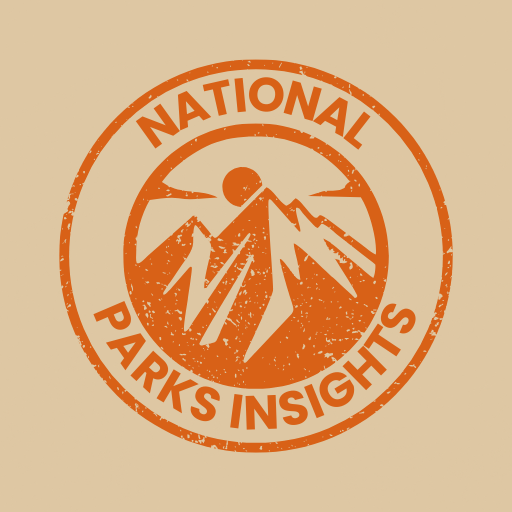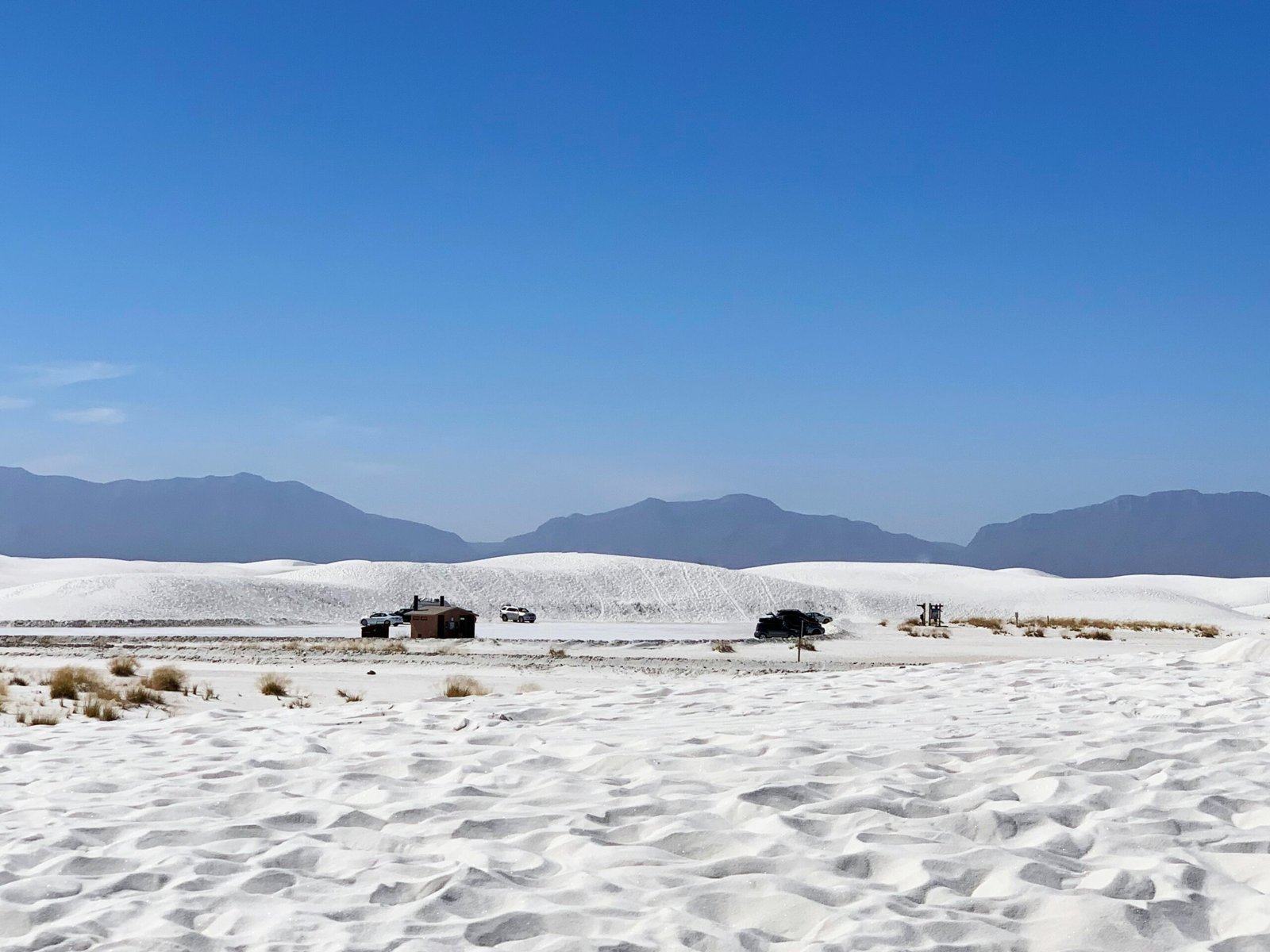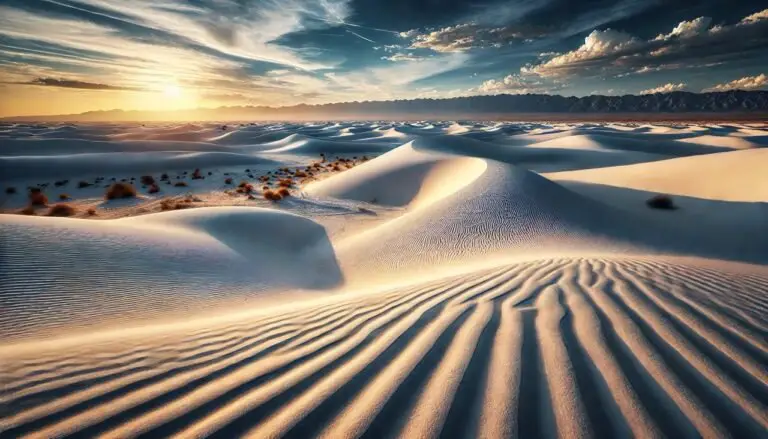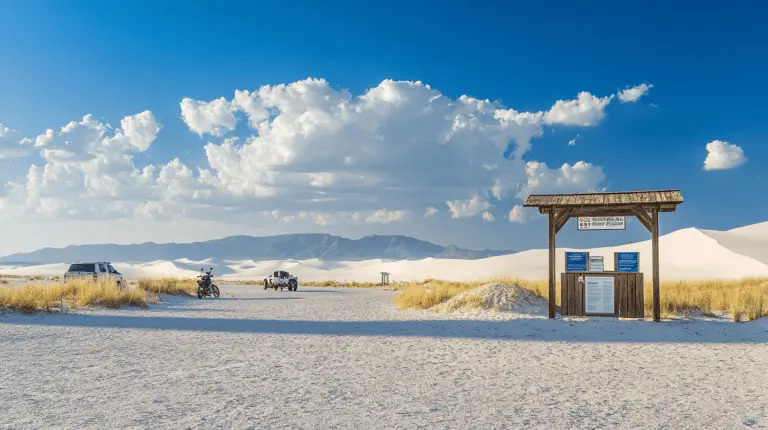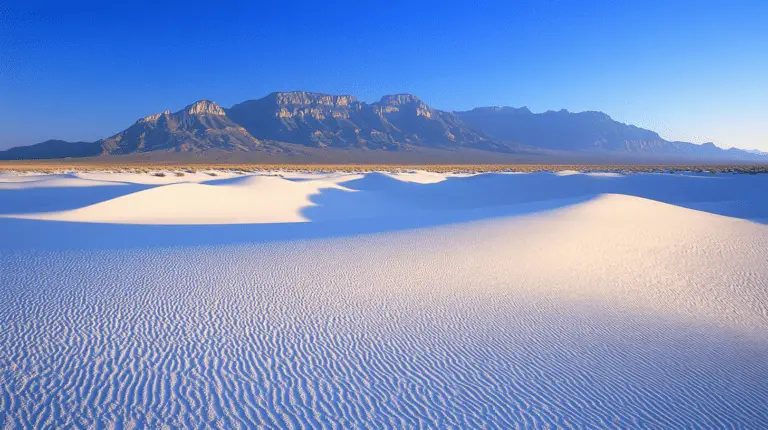White Sands Missile Range: A Hidden Gem
White Sands National Park is like stepping into a dream, where rolling white dunes stretch out as far as the eye can see, and the history feels almost tangible.
Where You’ll Find It
Smack dab in the heart of southern New Mexico lies the vast expanse of White Sands National Park, covering 145,762 acres (that’s about 227 square miles). These gleaming, white gypsum dunes are what make this place really stand out.
| Location | Size (sq mi) | Size (acres) |
|---|---|---|
| Southern New Mexico | 227 | 145,762 |
What’s Nearby?
- Just a stone’s throw from Alamogordo, New Mexico – about 15 miles southwest
- Coordinates: 32.7870° N, 106.3257° W
This park is also pretty near to the White Sands Missile Range, giving it an extra layer of mystery and excitement.
A Walk-Through History
White Sands National Park isn’t just a pretty face—it’s also a treasure trove of history. Native American tribes were the first to call this place home thousands of years ago. Over the centuries, the area has seen a lot of action and change.
One exciting chapter in its history involves the White Sands Missile Range. This site has been pivotal, not just for the U.S. military but also for space exploration. Established in 1945, it played a key role in atomic testing, the Apollo program, and even the Space Shuttle Program (Celestis).
| Historical Event | Who’s Involved |
|---|---|
| Atomic Testing | US Military |
| Apollo Program | NASA |
| Space Shuttle Program | NASA |
The history of White Sands adds depth and richness to your visit, blending natural beauty with fascinating stories of the past.
Curious to know more? Check out the full history of White Sands National Park for details on its unique geology and more.
For all you need on planning your trip, including visitor info and accessibility details, keep reading.
Visiting White Sands Missile Range
Taking a trip to the White Sands Missile Range is like stepping into a living museum of nuclear history and military tech. This iconic spot has tons to offer if you’re into the history of nuclear testing or curious about the latest in missile technology.
Trinity Site
The Trinity Site is the crown jewel of White Sands Missile Range. It’s where the Trinity test—the first-ever nuclear explosion—went down on July 16, 1945. This spot was declared a National Historic Landmark on December 21, 1965, and added to the National Register of Historic Places on October 15 of the following year.
Here, you can stand right where the atomic age began. There’s a small monument and some cool displays explaining the test and its huge impact. But don’t just rock up anytime—it’s only open to the public on the first Saturday in April and October. So, mark your calendar and plan ahead!
| Key Details | Information |
|---|---|
| Year Designated as National Historic Landmark | 1965 |
| First Nuclear Test Conducted | July 16, 1945 |
| Public Visiting Days | First Saturday in April and October |
Military Installations
White Sands isn’t all about history; it’s a hub for cutting-edge military testing and training. It started as the Alamogordo Bombing and Gunnery Range in 1941 but got its current name, White Sands Proving Ground, just after the Trinity test in 1945.
The White Sands Test Center, which operates here, handles complex missile testing and retrieval. It’s got a bunch of specialized branches dealing with everything from manned systems to electromagnetic radiation testing.
| Key Details | Information |
|---|---|
| Year Established | 1941 |
| Original Name | Alamogordo Bombing and Gunnery Range |
| Current Name Since | July 9, 1945 |
The range is flanked by Holloman Air Force Base on the east and the massive 600,000-acre McGregor Range Complex at Fort Bliss to the south. Together, these areas make up a huge space perfect for diverse military tests and training exercises.
For details on guided tours and fun stuff to do at White Sands, check out white sands national park tours.
Make your visit count. Whether you’re into its rich history or its high-tech military installations, White Sands Missile Range offers a peek into some major American milestones.
Activities at White Sands
White Sands National Park and White Sands Missile Range offer activities for everyone, from history buffs to adventure seekers, and those just looking to relax.
Guided Tours
Guided tours are a great way to uncover White Sands’ unique history and amazing views. You’ll get insider info that makes the experience even richer.
Types of Guided Tours:
- Missile Range Tours: Dive into the world of space tech at the White Sands Missile Range Museum. Check out rockets like the V-2 and Redstone and learn about the historic Trinity Site, the birthplace of the atomic bomb in 1945. More Info
- Park Ranger-Led Tours: Let a park ranger show you the amazing gypsum sand dunes and historic sites like the visitor center. These tours will give you a whole new appreciation for the park’s natural wonders. More Info
Fun & Relaxing Activities
There’s plenty to do beyond tours. White Sands is geared up to make your visit fun and memorable.
Things to Do:
- Picnicking: Since 1935, families have been picnicking in shaded areas with grills. It’s the perfect spot for a relaxing lunch. Park History
- Sledding: Grab a sled and glide down the dunes. Bring your own or pick one up at the visitor center.
- Hiking: Whether you’re up for a tough hike or a gentle stroll, there are trails for every level. Find Your Trail
- Shooting Range: Test your marksmanship at the well-maintained shooting range, perfect for both newbies and sharpshooters. More Info
Recreational Facilities Overview:
| Facility | What’s There | Where to Find It |
|---|---|---|
| Missile Range Museum | Rockets and space tech exhibits | White Sands Missile Range |
| Picnicking Areas | Shady spots with grills | Throughout the park |
| Sledding Dunes | Prime sledding areas | Near the visitor center |
| Hiking Trails | Easy to challenging paths | Across the park |
| Shooting Range | Target shooting fun | White Sands Missile Range |
Get the lowdown on everything by visiting our website’s detailed sections on tours and sledding. Make sure you’re fully prepped to make the most out of your White Sands adventure.
Plan Your Adventure
Ready to hit the sands of White Sands National Park and White Sands Missile Range? A bit of planning makes all the difference for a trip you’ll remember!
What to Know Before You Go
A little prep goes a long way. Here’s some essential info to help you out:
| What You Need to Know | Details |
|---|---|
| Where Is It? | White Sands National Park is in southern New Mexico. |
| Entrance Fees | Check the latest White Sands National Park Entrance Fee. |
| Visitor Center | The historic visitor center, upgraded in 2011, has a cool museum for all ages. More info here. |
| When to Visit? | See park hours here. |
For the freshest updates and any special advisories, look at the park’s official site or the National Park Service page.
Getting Around for Everyone
White Sands National Park aims to be inclusive, and they’ve made some great strides in accessibility. Here’s what you can expect:
| Facility | Accessibility Features |
|---|---|
| Visitor Center | Fully wheelchair-accessible including ADA-compliant restrooms (White Sands National Park Restrooms). |
| Boardwalk | The cool Interdune Boardwalk is a half-mile path into the dunes, fully wheelchair accessible (White Sands National Park Boardwalk). |
| Parking | Designated accessible parking spots at the visitor center and picnic areas. |
| Shuttle Service | Check if the park offers shuttle services for added convenience. |
For more details on making your visit smooth, peek at our White Sands National Park Accessibility guide. Knowing what to expect makes it easier to enjoy all the park and the White Sands Missile Range have to offer.
Wildlife and Nature
Flora and Fauna
White Sands National Park is like no other. Imagine 275 square miles of sparkling white gypsum dunes (Celestis). Despite the harsh conditions, this place is buzzing with life—plants and animals that have made this extreme environment their home.
Plants:
- Soaptree Yucca: You can’t miss this iconic plant with its tall, spiky leaves and towering flower stalks.
- Rio Grande Cottonwood: Found in the park’s wetter nooks, offering crucial shade and a home for critters.
- Gypsum-loving Fourwing Saltbush: Perfectly adapted to the salty, gypsum-rich soil.
Animals:
- Desert Cottontail: Often seen scurrying across the dunes.
- White Sands Pupfish: Unique to the park’s shallow pools.
- Bleached Earless Lizard: Its pale skin blends right in with the white sands.
Want the full scoop on the park’s biodiversity? Check out our pages on White Sands’ plants and White Sands’ animals.
Conservation Efforts
Don’t think the beauty of White Sands National Park stops at just looking pretty. The park is serious about protecting its gypsum ecosystems and the species that call it home. Here’s how they’re doing it:
- Habitat Preservation: Keeping the dunes and their unique areas safe for the animals and plants that live there.
- Visitor Education: The visitor center is packed with cool exhibits about the park’s nature and history.
- Sustainable Practices: Using eco-friendly methods to reduce our footprint on this beautiful place.
| Conservation Efforts | Details |
|---|---|
| Habitat Preservation | Keeping the fragile dunes and interdunal zones untouched. |
| Visitor Education | Engaging visitors with informative exhibits at the visitor center. |
| Sustainable Practices | Promoting eco-friendly practices to limit human impact. |
Want to dig deeper into these efforts? Swing by our pages on White Sands’ history and park rules.
Experience the wonders of White Sands while lending a hand in preserving it for the future. If you’re planning a visit, peek at our visitor info and packing tips.
Insider Tips for Your Visit
Best Times to Visit
White Sands National Park, with its vast white gypsum dunes that stretch over 275 square miles, is a captivating sight year-round. But a few seasons make it even more enjoyable.
- Spring (March to May): The temps are nice and the crowds light. Plus, the flowers? They make the dunes even more gorgeous.
- Fall (September to November): Much like spring, fall brings comfy temperatures and fewer people. Perfect for exploring!
- Winter (December to February): Cooler day temps—think 50s to 60s (°F). If you’re not a heat fan, this is your season.
- Summer (June to August): Hot, hot, hot. We’re talking 95°F plus. If you brave the heat, aim for early mornings or late evenings.
Here’s a quick rundown of what to expect weather-wise:
| Season | Average Temperature (°F) | Visitor Traffic |
|---|---|---|
| Spring | 60 – 80 | Low to Moderate |
| Summer | 85 – 95 | High |
| Fall | 55 – 75 | Low to Moderate |
| Winter | 30 – 60 | Low |
Plan your visit according to the weather at White Sands to make sure it lines up with your comfort zone.
What to Pack
A little prep goes a long way in making sure you have an awesome time at White Sands.
- Essentials:
- Water: Stay hydrated, it’s a desert after all.
- Sunscreen: The sun’s no joke out here.
- Hat and Sunglasses: Protect those peepers.
- Snacks: Think nuts, granola, stuff that keeps you fueled.
- Clothing:
- Layers: Weather can swing. Be ready.
- Comfortable Walking Shoes: Perfect for tackling the trails (White Sands hiking trails).
- Light Jacket: Nights can be chilly.
- Additional Gear:
- Camera: You’ll want to capture this place.
- Sled: Yep, sledding on sand is a thing here (White Sands sleds).
- Backpack: For all your stuff.
- Universal Items:
- First Aid Kit: Just in case.
- Map and Compass: Handy if you’re going to wander (White Sands map).
Need anything extra? The visitor center should have you covered, and check out the entrance fee details.
Finally, be sure to brush up on park regulations to keep your visit safe and the park pristine.
